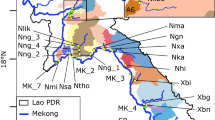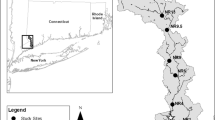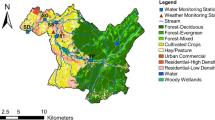Abstract
Fecal indicator bacteria, such as Escherichia coli, are frequently monitored in recreational waterbodies as indicators of potential fecal pathogen presence and exposure. The present watershed analysis investigated the influence of season on E. coli concentration (MPN/100 mL) and loading (MPN/day) measurements for inland waters at baseflow conditions. The master dataset collected during 2007–2012 for three watersheds included 896 E. coli (Colilert) samples with simultaneous flow taken for a subset (39 %) of samples. The outcomes for grouped watersheds were reflected in most cases for individual watersheds. Concentration- and loading-based results were highest in summer and spring, and lowest in the winter and fall, respectively. The comparison of these two measurement techniques (concentration and loading) highlight the impact of flow data during baseflow conditions for inland waters and reveal that caution should be used when inferring one method’s results from another.


Similar content being viewed by others
References
Amorim E, Ramos S, Bordalo AA (2014) Relevance of temporal and spatial variability for monitoring the microbiological water quality in an urban bathing area. Ocean Coast Manag 91:41–49
Cha SM, Lee SW, Park YE, Cho KH, Lee S, Kim JH (2010) Spatial and temporal variability of fecal indicator bacteria in an urban stream under different meteorological regimes. Water Sci Technol 61(12):3102–3108
Converse RR, Piehler MF, Noble RT (2011) Contrasts in concentrations and loads of conventional and alternative indicators of fecal contamination in coastal stormwater. Water Res 45:5229–5240
Dorevitch S, Ashbolt NJ, Ferguson CM, Fujioka R, McGee CG, Soller JA, Whitman RL (2010) Meeting report: knowledge and gaps in developing microbial criteria for inland recreational waters. Environ Health Perspect 118(6):871–876
Dwight RH, Fernandez LM, Baker DB, Semenza JC, Olson BH (2005) Estimating the economic burden from illnesses associated with recreational coastal water pollution—a case study in Orange County, California. J Environ Manag 76(2):95–103
Gentry RW, McCarthy J, Layton A, McKay LD, Williams D, Koirala SR, Sayler GS (2006) Escherichia coli loading at or near base flow in a mixed-use watershed. J Environ Qual 35(6):2244–2249
Gentry-Shields J, Rowny JG, Stewart JR (2012) HuBac and nifH source tracking markers display a relationship to land use but not rainfall. Water Res 46:6163–6174
Hörman A, Rimhanen-Finne R, Maunula L, von Bonsdorff C-H, Torvela N, Heikinheimo A, Hänninen M-L (2004) Campylobacter spp., Giardia spp., Cryptosporidium spp., Noroviruses, and indicator organisms in surface water in southwestern Finland, 2000–2001. Appl Environ Microbiol 70(1):87–95
Ishii S, Ksoll WB, Hicks RE, Sadowsky MJ (2006) Presence and growth of naturalized Escherichia coli in temperate soils from Lake Superior watersheds. Appl Environ Microbiol 72(1):612–621
Jamieson RC, Gordon RJ, Tattrie SC, Stratton GW (2003) Sources and persistence of fecal coliform bacteria in a rural watershed. Water Qual Res J Can 38(1):33–47
Koirala SR, Gentry RW, Perfect E, Schwartz JS, Sayler GS (2008) Temporal variation and persistence of bacteria in streams. J Environ Qual 37(4):1559–1566
Leisenring M, Clary J, Hobson P (2012) International stormwater best management practices (BMP) database pollutant category summary statistical addendum: TSS, bacteria, nutrients, and metals. International Stormwater BMP Database. http://www.bmpdatabase.org/Docs/2012%20Water%20Quality%20Analysis%20Addendum/BMP%20Database%20Categorical_SummaryAddendumReport_Final.pdf. Accessed 8 March 2016
Marion JW, Lee J, Lemeshow S, Buckley TJ (2010) Association of gastrointestinal illness and recreational water exposure at an inland US beach. Water Res 44(16):4796–4804
North RL, Khan NH, Ahsan M, Prestie C, Korber DR, Lawrence JR, Hudson JJ (2014) Relationship between water quality parameters and bacterial indicators in a large prairie reservoir: Lake Diefenbaker, Saskatchewan, Canada. Can J Microbiol 60(4):243–249
Rowny JG, Stewart JR (2012) Characterization of nonpoint source microbial contamination in an urbanizing watershed serving as a municipal water supply. Water Res 46:6143–6153
Shirmohammadi A, Chaubey I, Harmel R, Bosch D, Muñoz-Carpena R, Dharmasri C (2006) Uncertainty in TMDL models. Trans ASABE 49(4):1033–1049.
Shuval H () Estimating the global burden of thalassogenic diseases: human infectious diseases caused by wastewater pollution of the marine environment. J Water Health 1(2):53–64
Stumpf CH, Piehler MF, Thompson S, Noble RT (2010) Loading of fecal indicator bacteria in North Carolina tidal creek headwaters: hydrographic patterns and terrestrial runoff relationships. Water Res 44(16):4704–4715
TDEC (2009) Quality systems for standard operating procedure for chemical and bacteriological sampling of surface water. Tennessee Department of Environment and Conservation, Division of Water Pollution Control, Nashville
TDEC (2014) Proposed Final Version, Year 2014 303(d) List. Tennessee Department of Environment and Conservation, Planning and Standards Unit Division of Water Resources, Nashville
Traister E, Anisfeld SC (2006) Variability of indicator bacteria at different time scales in the upper Hoosic River watershed. Environ Sci Technol 40(16):4990–4995
USEPA (2001) Protocol for Developing Pathogen TMDLs. (EPA-841/R-00-002). U.S. Environmental Protection Agency, Office of Water, Washington
USEPA (2003) Bacterial Water Quality Standards for Recreational Waters (Freshwater and Marine Waters) Status Report. (EPA-823/R-03-008) U.S. Environmental Protection Agency, Office of Water, Washington
USEPA (2010) Report on National Epidemiological and Environmental Assessment of 60 Recreational Water Epidemiological Studies. (NEEAR 2010-Surfside & Boqueron)(EPA-600/R-10-168), U.S. Environmental Protection Agency, Office of Research and Development, Cincinnati
USEPA (2012) Recreational Water Quality Criteria. (EPA-820-F-12-058) U.S. Environmental Protection Agency, Office of Water, Washington
Vidon P, Tedesco LP, Wilson J, Campbell MA, Casey LR, Gray M (2008) Direct and indirect hydrological controls on concentration and loading in midwestern streams. J Environ Qual 37(5):1761–1768
Wilkes G, Edge T, Gannon V, Jokinen C, Lyautey E, Medeiros D, Lapen DR (2009) Seasonal relationships among indicator bacteria, pathogenic bacteria, Cryptosporidium oocysts, Giardia cysts, and hydrological indices for surface waters within an agricultural landscape. Water Res 43(8):2209–2223
Wittenberg H (2003) Effects of season and man-made changes on baseflow and flow recession: case studies. Hydrol Process 17:2113–2123
Acknowledgments
This project was supported by Middle Tennessee State University Molecular Biosciences Program.
Author information
Authors and Affiliations
Corresponding author
Rights and permissions
About this article
Cite this article
Stallard, M.A., Otter, R.R., Winesett, S. et al. A Watershed Analysis of Seasonal Concentration- and Loading-based Results for Escherichia coli in Inland Waters. Bull Environ Contam Toxicol 97, 838–842 (2016). https://doi.org/10.1007/s00128-016-1928-y
Received:
Accepted:
Published:
Issue Date:
DOI: https://doi.org/10.1007/s00128-016-1928-y




